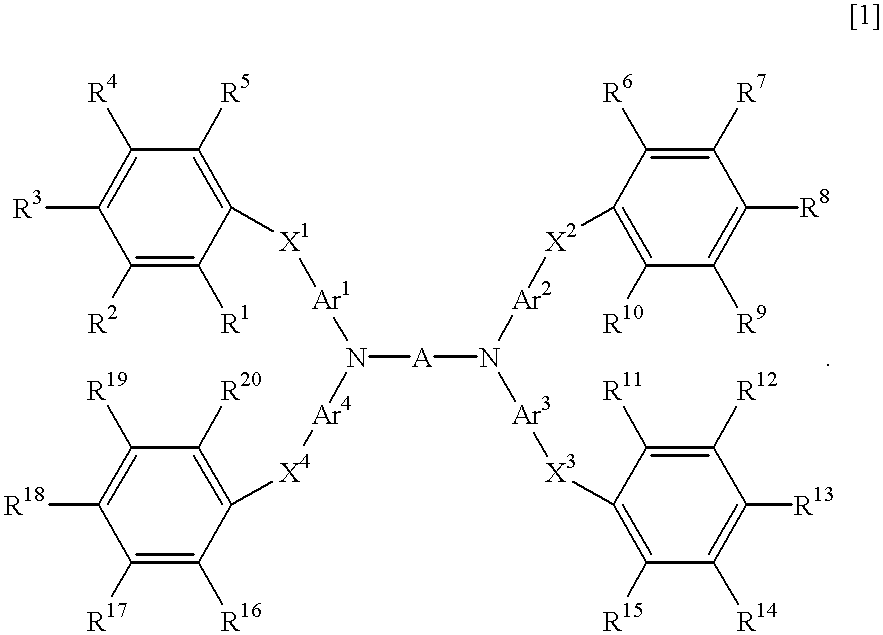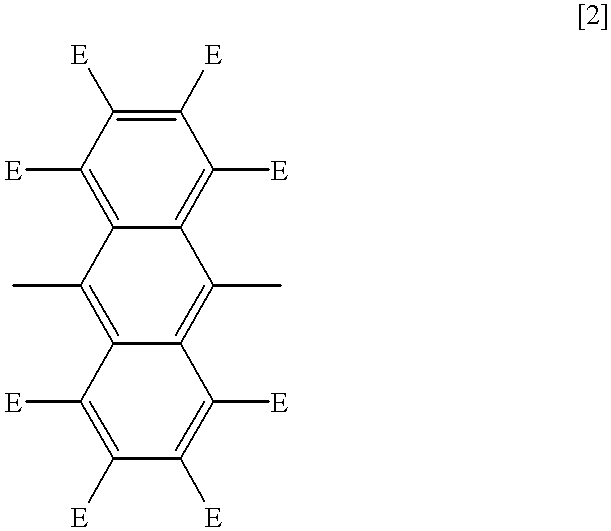Light-emitting material for organo-electroluminescence device and for organic electroluminescence device which the material is applied
a technology of light-emitting materials and organoelectroluminescence devices, applied in the direction of diaryl/triaryl methane dyes, natural mineral layered products, anthracene dyes, etc., can solve the problems of low light emission brightness and light emission efficiency of conventional organic el devices, and no organic el device has been put to practical us
- Summary
- Abstract
- Description
- Claims
- Application Information
AI Technical Summary
Problems solved by technology
Method used
Image
Examples
example 1
Compound (1) in Table 3 as a light-emitting material, 2,5-bis(1-naphthyl)-1,3,4-oxadiazole and a polycarbonate resin (Panlite K-1300, supplied by Teijin Kasei) in a weight ratio of 5:3:2 were dissolved in tetrahydrofuran, and the solution was spin-coated on a cleaned glass substrate with an ITO electrode to form a light-emitting layer having a thickness of 100 nm. An electrode having a thickness of 150 nm was formed thereon from a magnesium / indium alloy having a magnesium / indium mixing ratio of 10 / 1, to obtain an organic EL device. The device had the following light emission characteristics. The device showed blue light emission having a brightness of 90 (cd / m.sup.2) at a direct current voltage of 5 V, a maximum brightness of 1,500 (cd / m.sup.2) and a light emission efficiency of 0.50 lm / W.
example 2
Compound (2) in Table 3 was vacuum-deposited on a cleaned glass substrate with an ITO electrode to form a light-emitting layer having a thickness of 100 nm. An electrode having a thickness of 100 nm was formed thereon from a magnesium / silver alloy having a magnesium / silver mixing ratio of 10 / 1, to obtain an organic EL device. The light-emitting layer was formed by deposition under a vacuum of 10.sup.-6 Torr at a substrate temperature of room temperature. The device showed green light emission having a brightness of 260 (cd / m.sup.2) at a direct current voltage of 5 V, a maximum brightness of 800 (cd / m.sup.2) and a light emission efficiency of 0.60 lm / W.
example 3
Compound (3) in Table 3 was dissolved in methylene chloride tetrahydrofuran, and the solution was spin-coated on a cleaned glass substrate with an ITO electrode to form a light-emitting layer having a thickness of 50 nm. Then, aluminum bis(2-methyl-8-quinolinate)(2-naphtolate) was vacuum-deposited to form an electron-injecting layer having a thickness of 10 nm, and an electrode having a thickness of 100 nm was formed thereon from a magnesium / aluminum alloy having a magnesium / aluminum mixing ratio of 10 / 1, to obtain an organic EL device. The light-emitting layer and the electron-injecting layer were formed by deposition under a vacuum of 10.sup.-6 Torr at a substrate temperature of room temperature. The device showed bluish green light emission having a brightness of 200 (cd / m.sup.2) at a direct current voltage of 5 V, a maximum brightness of 12,000 (cd / m.sup.2) and a light emission efficiency of 1.2 lm / W.
PUM
| Property | Measurement | Unit |
|---|---|---|
| Current | aaaaa | aaaaa |
| Current | aaaaa | aaaaa |
| Current | aaaaa | aaaaa |
Abstract
Description
Claims
Application Information
 Login to View More
Login to View More - R&D
- Intellectual Property
- Life Sciences
- Materials
- Tech Scout
- Unparalleled Data Quality
- Higher Quality Content
- 60% Fewer Hallucinations
Browse by: Latest US Patents, China's latest patents, Technical Efficacy Thesaurus, Application Domain, Technology Topic, Popular Technical Reports.
© 2025 PatSnap. All rights reserved.Legal|Privacy policy|Modern Slavery Act Transparency Statement|Sitemap|About US| Contact US: help@patsnap.com



